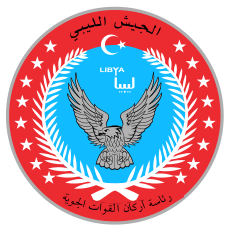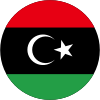Libyan Air Force (1951–2011)
| Libyan Air Force | |
|---|---|

Libyan Air Force emblem.
|
|
| Active | 1962 (current form 2011) |
| Country |
|
| Type | Air force |
| Role | Close air support,territorial sovereignty missions |
| Size | 4,500 personnel |
| Equipment | 32+ aircraft (including helicopters) 22 helicopters |
| Engagements |
Six-Day War Yom Kippur War Libyan–Egyptian War Chadian–Libyan conflict Gulf of Sidra incident (1981) Gulf of Sidra incident (1989) Libyan Civil War (2011) Post-civil war violence in Libya Libyan Civil War (2014–present) |
| Commanders | |
| Chief of Staff | Saqr Geroushi |
| Notable commanders |
Commander Mahmoud Berrhouma |
| Insignia | |
| Flag |  |
| Roundel |  |
| Fin Flash |  |
| Aircraft flown | |
| Attack | Su-22 |
| Fighter | MiG-21, MiG-23, Mirage F1 |
| Helicopter | Mi-8, possibly CH-47 Chinook, possibly Mi-2, possibly AW139 |
| Attack helicopter | Mi-24 |
| Multirole helicopter | possibly Mi-14 |
| Trainer | N/A |
| Transport | Il-76 |
The Libyan Air Force (Arabic: القوات الجوية الليبية) is the branch of the Libyan military responsible for aerial warfare. In 2010, before the Libyan Civil War, the Libyan Air Force personnel strength was estimated at 18,000, with an inventory of 374 combat capable aircraft operating from 13 military airbases in Libya.
The air force was first established as the Royal Libyan Air Force (Al Quwwat al Jawwiya al Malakiya al Libiyya) in september 1962 by a decision of the minister of defense Younis Bel Khayer, Lt. Col. Salim al-Hsoumi and Lt. Col. Mohamed Shennib were assigned to lead the new force. It was originally equipped with a small number of transports and trainers: Douglas C-47s and Lockheed T-33s. However, F-5 Freedom Fighters were delivered from 1967. In 1970 it changed its name to the Libyan Arab Republic Air Force. After U.S. forces left Libya in 1970, Wheelus Air Base, a previous U.S. facility about 11 kilometres (6.8 mi) from Tripoli, became a LAR Air Force installation and was renamed Okba Ben Nafi Air Base. The base housed the LARAF's headquarters and a large share of its major training facilities. From 1970 a significant expansion of the air force took place, with a large number of Soviet and some French combat aircraft being purchased.
During May 1967 the Kingdom of Libya reached an agreement with the United States to supply 10 Northrop F-5s to the Royal Libyan Air Force. These were the first fighters for the young Air Force which only operated at the time six Douglas C-47 transports and three Lockheed T-33A trainers. Fifty-six personnel underwent training at bases in the U.S., pilots at Williams Air Force Base; a U.S. Survey Team on Expansion came to Libya in August 1968 to supervise the introduction of the fighters. Serviceability of the F-5s declined after the 1969 coup and it appears that most may have eventually been sold to Turkey.
LARAF Soviet-made MiG-17/19/25 fighters and Tu-22 bombers were based at Okba Ben Nafi Air Base. After the 1969 seizure of power by Colonel Gaddafi, aircraft and personnel of the Soviet Air Force took residence at Okba Ben Nafi Air Base. With Soviet assistance, the Libyan Arab Republic Air Force was organized into one medium bomber squadron with Tupolev Tu-22s, three fighter interceptor squadrons, five forward ground attack squadrons, one counter-insurgency squadron, nine helicopter squadrons, and three air defense brigades deploying SA-2, SA-3, and Crotale missiles. Of the combat aircraft, the United States Department of State estimated in 1983 that 50 percent remained in storage, including most of the MiG fighters and Tu-22 bombers. In 1971, 11 civilian C-130's were delivered by the United States and converted in Italy to military versions. Four L-100-30's were purchased from the Philippines and Luxembourg in 1981. In 1976, 20 CH-47 Chinook heavy transport helicopters were acquired from Italy, 14 of which were transferred to the army during the 1990s. Libya also received 53 Dassault Mirage 5D and 32 5DE from France along with 15 5DD and 10 5DR followed by 16 Dassault Mirage F1AD, 6 F1BD & 16 F1ED aircraft.
...
Wikipedia
